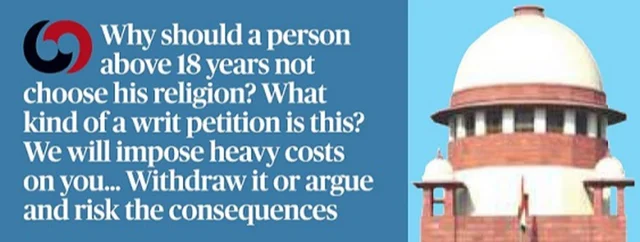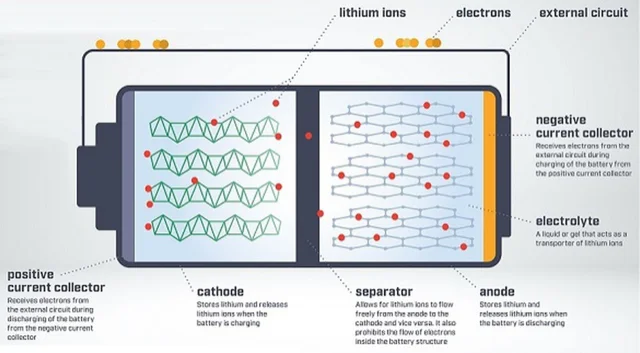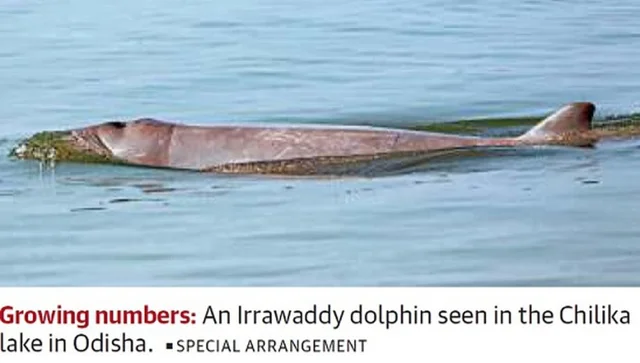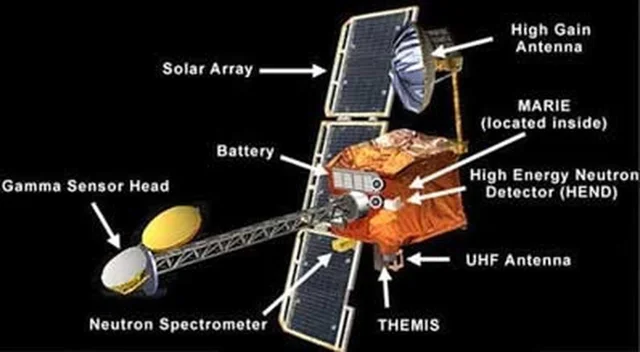IASbaba's Daily Current Affairs Analysis
Archives
(PRELIMS + MAINS FOCUS)
SC’s views on religious conversions
Part of: GS Prelims and GS – II – Fundamental Rights
In news
- The SC said that people are free to choose their religion and it lashed out at a petition claiming there is mass religious conversion happening “by hook or by crook” across the country.

Key takeaways
- It said that people have a right under the Constitution to profess, practise and propagate religion.
- Article 25: It grants Fundamental right to freely profess, practise and propagate religion, subject to public order, morality and health.
- Every person is the final judge of his/her choice of religion or who their life partner should be.
- Courts cannot sit in judgment of a person’s choice of religion or life partner.
- Religious faith is a part of the fundamental right to privacy.
- The Constitution Bench judgment had earlier upheld inviolability of the right to privacy, equating it with the rights to life, of dignity and liberty.
USA carries out Freedom of Navigation Operation (FONOP) in the Indian EEZ
Part of: GS Prelims and GS – II – International Relations
In news
- India has protested the U.S. decision to conduct a patrol in the Indian Exclusive Economic Zone (EEZ) in the western Indian Ocean.
Key takeaways
- U.S. Navy announced that its ship, USS John Paul Jones, had carried out Freedom of Navigation Operation (FONOP) in the Indian EEZ, adding that its operations had “challenged” what the U.S. called India’s “excessive maritime claims”.
- The ship asserted navigational rights and freedoms approximately 130 nautical miles west of the Lakshadweep Islands, inside India’s exclusive economic zone, without requesting India’s prior consent, consistent with international law.
- The Government of India’s stated position on the United Nations Convention on the Law of the Sea (UNCLOS) is that the Convention “does not authorise other States to carry out in the EEZ and on the continental shelf, military exercises or manoeuvres, in particular those involving the use of weapons or explosives, without the consent of the coastal state.
- While India ratified UNCLOS in 1995, the U.S. has failed to do it so far.
Technique to improve the performance of lithium-ion batteries developed
Part of: GS Prelims and GS – III Sci & tech
In news
- Researchers from IIT Guwahati have developed a technique to improve the performance of rechargeable lithium-ion batteries, which power most of the portable devices used today.

Important value additions
- The 2019 Nobel Prize in Chemistry was jointly awarded to Stanley Whittingham, John Goodenough and Akira Yoshino for work that led to the development of lithium-ion batteries.
- These batteries are used in most mobile phones, smartphones, tablets, laptops and power banks, among other devices.
- Today, most Electrical Vehicles (EV) use Li-ion batteries as well, but are slowly reaching their theoretical limits of being able to provide roughly up to 300-watt hour per kilogram of energy.
- These batteries can also be used to store solar and wind power, which means that with their widespread use it may even be possible to live in a fuel free society.
Disadvantages
- Li-ion batteries are susceptible to overheating and are prone to damage at high voltages since they are made with flammable and combustible materials.
- Such batteries also start losing their capacity over time
Alternatives to Li-ion batteries
- In January 2020, researchers from Australia claimed that they developed the world’s most efficient lithium-sulfur (Li-S) battery, capable of powering a smartphone for five continuous days
- Li-S batteries are generally considered the successors of Li-ion batteries because of their lower cost of production, energy efficiency and improved safety.
- Their cost of production is lower because sulfur is abundantly available.
Population of dolphins in Chilika lake doubled this year
Part of: GS Prelims and GS – III – Biodiversity; Environment
In news
- The population of dolphins in Chilika, India’s largest brackish water lake, and along the Odisha coast has doubled this year compared with last year.

Key takeaways
- The State Environment Department released the final data on the dolphin census conducted in January and February 2021, indicating a spectacular growth in numbers.
- Three species were recorded during the census,.
- 544 Irrawaddy, bottle-nose and humpback dolphins were sighted this year, compared with 233 last year.
- The endangered Irrawaddy dolphins are mostly found in Chilika lake.
- The highest growth has been noticed in the case of humpback dolphins with a population of 281.
- These humpback dolphins were not part of any riverine systems, so they cannot be identified as residential mammals. They were spotted travelling along the Odisha coast and the number is likely to fluctuate in the next census.
SAAMAR Campaign by Jharkhand government
Part of: GS Prelims and GS – II – Policies and interventions
In news
- SAAMAR (Strategic Action for Alleviation of Malnutrition and Anemia Reduction) campaign has been launched by Jharkhand government to tackle malnutrition in the state.
Key takeaways
- The campaign aims to identify anaemic women and malnourished children and converge various departments to effectively deal with the problem
- It has a 1000 days target, under which annual surveys will be conducted to track the progress.
- To tackle severe acute malnutrition children, every Anganwadi Centres will be engaged to identify these children and subsequently will be treated at the Malnutrition Treatment Centres.
- In the same process the anaemic women will also be listed and will be referred to health centres in serious cases.
- Angawadi’s Sahayika and Sevika will take them to the nearest Health Centre where they will be checked again and then registered on the portal of State Nutrition Mission.
Miscellaneous
2001 Mars Odyssey
-
NASA’s Mars Odyssey spacecraft marks 20 years of mapping it.

- It is the oldest spacecraft still working at the Red Planet.
- It was sent to map the composition of Mars in 2001.
- The feasibility of humans traveling to Mars was also the focus of an instrument aboard Odyssey that measured how much space radiation astronauts would have to contend with
The most complete global maps of Mars were made using Odyssey’s infrared camera, called the Thermal Emission Imaging System, or THEMIS.
(Mains Focus)
SOCIETY/ GOVERNANCE/ SECURITY
Topic:
- GS-2: Government policies and interventions for development in various sectors and issues arising out of their design and implementation
- GS-2: Rights and Freedoms
India’s Refugee Problem
Context: Myanmarese citizens, including little children fleeing from a Myanmar’s military, being turned away at the Indian border in the Northeast has once again revived the domestic debate about refugee protection in India.
India’s Refugee Problem
- Refugee flows to India are unlikely to end any time soon given the geopolitical, economic, ethnic and religious contexts of the region.
- There is an urgent need to clinically address the issue of refugee protection in India and put in place appropriate legal and institutional measures.
Issues/Challenges
- Lacks differentiation b/w Refugees & illegal Immigrants: Illegal Immigration and Refugees are two different things. However, as per Indian law, both categories of people are viewed as one and the same and are covered under the Foreigners Act, 1946. Due to this, government’s policies and remedies to deal with these issues suffer from a lack of clarity as well as policy utility.
- Lack of Proper Legal Framework: India is legally ill-equipped to deal with refugees and illegal immigrants separately due to a lack of legal provisions. India is not a party to the 1951 Refugee Convention and its 1967 Protocol the key legal documents pertaining to refugee protection.
- Ad-hocism in dealing with refugees: The absence of such a legal framework also leads to policy ambiguity whereby India’s refugee policy is guided primarily by ad hocism which, of course, often has its own ‘political utility’.
- Domestic politicisation of refugee protection Absence of a legal framework and Ad hoc measures enable the government in office to pick and choose ‘what kind’ of refugees it wants to admit for whatever political or geopolitical reasons, and what kind of refugees it wants to avoid giving shelter, for similar reasons.
- Complicates geopolitical faultlines: Absence of legal framework & politicization of refugee problem opens the door for geopolitical considerations while deciding to admit refugees or not.
- Example: Consider the most recent case of Myanmarese refugees fleeing to India for protection from the junta at home.
- New Delhi’s concern is that if it takes a decision that irks the Generals in Myanmar, Beijing would get closer to the junta and use the opportunity to hurt India’s interests in Myanmar.
- If New Delhi had a domestic legislation regarding refugees, despite not being a signatory to the relevant international conventions, it could have tempered the expectations of the junta to return the fleeing Myanmarese.
- Credibility of India as responsible power questioned: India, for the most part, has had a stellar record on the issue of refugee protection, a moral tradition that has come under great stress of late. New Delhi has been one of the largest recipients of refugees in the world in spite of not being a party to the 1951 Refugee Convention and its 1967 Protocol.
Why India has not signed 1951 Refugee Convention?
- Lop-sided definition of Refugee that favours West
- The definition of refugees in the 1951 convention only pertains to the violation of civil and political rights, but not economic rights, of individuals, for instance.
- If the violation of economic rights were to be included in the definition of a refugee, it would clearly pose a major burden on the developed world.
- Poor Track record of Developed Countries
- India should not accede to the 1951 convention at a time when the North is violating it in both letter and spirit.
- India should argue that their accession is conditional on the Western States rolling back the non-entrée (no entry) regime they have established over the past two decades.
- The non-entrée regime is constituted by a range of legal and administrative measures that include visa restrictions, carrier sanctions, restrictive interpretations of the definition of ‘refugee’, withdrawal of social welfare benefits to asylum seekers, and widespread practices of detention
Way Ahead – New Domestic Law
- A domestic refugee law should allow for temporary shelter and work permit for refugees.
- This is crucial because in the absence of proper legal measures, refugee documentation, and work permit, refugees may end up becoming illegal immigrants using illicit means.
- Make a distinction between temporary migrant workers, illegal immigrants and refugees and deal with each of them differently through proper legal and institutional mechanisms.
Connecting the dots:
- Rohingya Refugee Problem
GOVERNANCE/ SOCIETY
Topic:
- GS-2: Functions and responsibilities of the Union and the States; Government policies and interventions for development in various sectors
Uttarakhand’s Char Dham Board
Context: Uttarakhand Char Dham Devasthanam Management Act was enacted by Uttarakhand State legislature in 2019.
Under the same Act, the State government constituted the Uttarakhand Char Dham Devasthanam Board on January 15, 2020.
- Under this board, at present there are 53 temples, including four shrines – Badrinath, Kedarnath, Gangotri and Yamunotri – and other temples located around these shrines.
- The shrine board is the highest governing body for the management of the temples with powers to frame policies, make decisions to give effect to the provisions of this Act, of budget formulation and to sanction expenditure, among others.
- The board may also give directions for the safe custody, prevention and management of funds, valuable securities, jewellery and properties vested in the temples.
- Through the Devasthanam board, the government has taken control over the financial and policy decisions
What was the previous arrangement?
- Earlier, the Shri Badrinath-Shri Kedarnath Act, 1939 was in place for the management of two shrines (Badrinath and Kedarnath) and 45 temples by Shri Badrinath- Shri Kedarnath Mandir Samiti.
- The Samiti was chaired by a government appointed person whereas an official of all India service used to be the CEO.
- All the decisions related to utilization of the donations, funds and development works in and around those 45 temples including Badrinath and Kedarnath were taken by that committee and the government did not intervene into it.
- In Gangotri and Yamunotri, management of the shrines was earlier in the control of local trusts and the government was not getting any share from the donations made by devotees.
Who are protesting and why?
- Priests, Pandas, Dimris and others who run dharmshalas and shops at the Badrinath and Kedarnath shrines staged protests in Dehradun.
- They alleged that with the shrine board, the government will get control of the entire area and donations.
- Some argue that Hindu temples should be governed by the Hindu society and the governments should not have any control over management of temples, its properties and religious systems.
What does the government say?
- Constitutional Validity of Act upheld by Judiciary: The Uttarakhand High Court in July 2020 had dismissed a PIL challenging the constitutional validity of 2019 Act. The Court held that Char Dham and associated temples are public temples whose secular functions can be regulated by a law made by the competent legislature.
- Responsibility & Right of Government: When the government looks after the security and other arrangements for convenience of pilgrims, the government should have control over utilization of funds and planned development of the area. Devasthanam board gives such power to the government
- Enhances Public Services: The State government argues that the public is in support of the devasthanam board because they want good services there and the government only provides these services to them
- Stakeholders Rights Safeguarded: The government has introduced the clause protecting the rights of teerth-purohits, rawals and pandas. The act is therefore not interfering with the traditions & religious activities but only regulating the secular functions of the Temples
(TEST YOUR KNOWLEDGE)
Model questions: (You can now post your answers in comment section)
Note:
- Correct answers of today’s questions will be provided in next day’s DNA section. Kindly refer to it and update your answers.
- Comments Up-voted by IASbaba are also the “correct answers”.
Q.1 Which of the following is the largest brackish water lake in India?
- Dal Lake
- Chilika Lake
- Sambhar Lake
- Vembanad lake
Q.2 Which of the following is the IUCN status of Irrawaddy dolphin?
- Endangered
- Critically endangered
- Least concerned
- Vulnerable
Q.3 Which of the following article deals with Fundamental right to freely profess, practise and propagate religion, subject to public order, morality and health?
- Article 26
- Article 25
- Article 27
- Article 28
Q.4 SAAMAR (Strategic Action for Alleviation of Malnutrition and Anemia Reduction) campaign has been launched by which of the following state government?
- Rajasthan
- Madhya Pradesh
- Jarkhand
- Uttar Pradesh
ANSWERS FOR 10th April 2021 TEST YOUR KNOWLEDGE (TYK)
| 1 | C |
| 2 | C |
Must Read
On significance of Indo-Pacific for Europe:
On US challenging India’s maritime rights:
On Personal Data Protection Bill:











